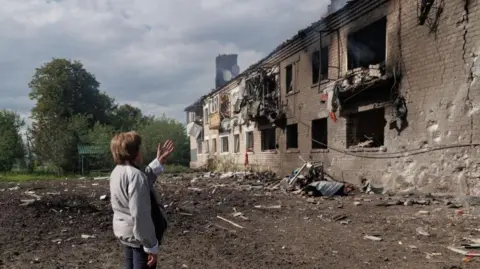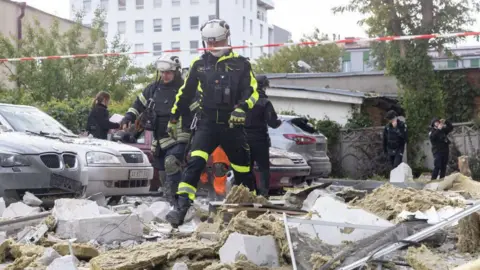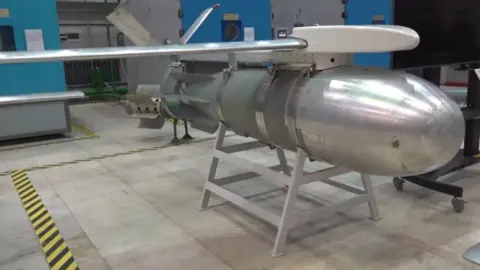Russia's glide bombs devastating Ukraine's cities on the cheap
 Yakiv Liashenko/Anadolu via Getty Images
Yakiv Liashenko/Anadolu via Getty ImagesRussia is increasingly using "glide bombs" - cheap but highly destructive ordnance - to advance its offensive in Ukraine.
More than 200 of them are thought to have been used in just a week to pound Ukraine’s northern town of Vovchansk during Russia’s current cross-border advance near Kharkiv.
Warning: You may find some of the details in this piece disturbing
President Volodymyr Zelensky said 3,000 such bombs were dropped on the country in March alone.
Vovchansk police chief Oleksii Kharkivsky has seen the impact of glide bombs up close.
 Russian Ministry of Defence
Russian Ministry of Defence“There are no words to describe the aftermath of a glide bomb attack," he says. "You arrive to see people who are lying there, torn apart.”
The mass use of glide bombs by Russia is a relatively recent development, one that has proven devastating for Ukrainian forces in recent months.
Glide bombs are built by adding fold-out wings and satellite navigation to old Soviet bombs. They are cheap but destructive.
A recent report by the Centre for European Policy Analysis (CEPA) said they were decisive in February’s capture of the once heavily fortified key eastern town of Avdiivka.
Russian forces are now using glide bombs to attack the northern city of Kharkiv. Ukraine has so far struggled to counter them.
 Yevhen Titov/Global Images Ukraine
Yevhen Titov/Global Images UkraineThe Vovchansk police chief has been helping to evacuate front-line border villages in the Kharkiv region, where Russian forces have recently been advancing.
Parked up in his police car, he tells us the scale of attacks has increased dramatically.
“Over the past six months, we were hit by glide bombs quite often, maybe five to 10 bombs per week… but this month we’ve had far more than ever," he said.
Russia is able to stockpile glide bombs in high quantities because they are quite easily produced.
“The explosive part is essentially a conventional freefall iron bomb, of which Russia has hundreds of thousands in storage from the Soviet period,” says Prof Justin Bronk, airpower and military technology specialist at the Royal United Services Institute (Rusi).
“They are fitted with pop-out wings which, after the bomb is dropped, will flick out to allow it to glide much longer distances.”
Their attached satellite guidance system allows targeting of a stationary position with relatively high accuracy.
According to Prof Bronk, the mechanism of the bombs gives the Russians much of the functionality of a multi-million dollar missile, but for a fraction of the cost.
He says that glide kits - which are mass-produced and pretty mechanically simple - are added to Soviet bombs, of which the Russians have a plentiful supply - meaning the cost per weapon can be "somewhere in the region of $20,000 to $30,000 (£15,700-£23,600)".
The concept is not new. The Germans deployed the Fritz-X during World War Two. In the 1990s the US military developed the Joint Attack Direct Munition, or JDAM, which added steerable tail fins and GPS guidance to traditional free-fall bombs. They have been used extensively since, including in Iraq and Afghanistan.
 Russian defence ministry
Russian defence ministryThe destruction that the glide bombs create is extraordinary. The ordnance thought to be most commonly used for glide bombs is the FAB-1500, which weighs 1.5 tonnes.
For comparison, a Russian 152mm shell contains about 6.5kg of explosive material. Even the smallest glide bomb, the FAB-500, contains more than 200kg.
They turn even well-fortified Ukrainian positions into vulnerable targets.
Because glide bombs create far greater explosive power, they are more likely to cause cave-ins or fatalities even in quite well-fortified positions, Prof Bronk explains. The powerful blasts also have severe effects on the human body.
Glide bombs "are making Ukraine's defensive strategy more difficult because the Russians can just continually bombard fixed positions until they're gone", Prof Bronk says.
Ukrainian security analyst Mariia Zolkina tells the BBC that the use of glide bombs is a worrying development, and that the bombs are creating a "new era" for the military situation on the ground.
"They allow Russia to wipe out Ukrainian defensive lines without using their infantry," Ms Zolkina says. "They have a completely different effect to artillery fire or even missile strikes.”
George Barros from the US-based Institute for the Study of War (ISW) says that while Ukraine’s situation is difficult, another worrying development could be just around the corner.
He notes there is evidence that a factory about 400km (250 miles) east of Moscow is setting up a production line capable of churning out glide bombs weighing more than three tonnes.
If glide bombs of that size were to start being routinely dropped on Ukrainian positions, the impact would be vast - both on fortifications and the morale of the people trying to hold them.
 UA:PBC"/Global Images Ukraine
UA:PBC"/Global Images Ukraine So what can be done to counter glide bombs?
Prof Bronk says that intercepting the bombs mid-flight is not a viable solution because of the sheer number the Russians have at their disposal. "You would blow through all the available air defence ammunition too quickly," he says.
The only solution, bar a ground incursion, is to target the planes that drop them, either in flight or on the ground.
But that comes with significant risks.
The US Patriot surface-to-air missile launcher system can shoot the fighter-bombers down - but only if it is positioned near the front lines. This carries the risk of being spotted by Russian drones and hit with ballistic missiles, Prof Bronk says - something that happened to two launchers earlier this year.
This leaves the option of using long-range missiles or drones to target Russian air bases.
It is a method Ukraine has been employing. In April, Kyiv claimed to have used a barrage of drones to destroy at least six military aircraft and badly damage eight others at an airfield in Russia’s southern Rostov region.
This solution, however, is not without its problems. The US - the biggest provider of Ukrainian military aid - prohibits Kyiv from using any of its weapons systems on internationally recognised Russian territory. While this does not include Crimea or occupied Ukraine, it does mean that airfields inside Russia are off-limits.
So, for now, it seems there is no easy answer for Ukraine.
President Volodymyr Zelensky has repeatedly called for more air defence missiles and the supply of modern fighter jets.
But for now, Mariia Zolkina says morale has been affected by the increased use of glide bombs.
“The military do not feel safe because their fortifications can’t protect them, while civilians living in Kharkiv, people used to living under shelling, can’t escape a bomb which can destroy a seven-storey building.”
